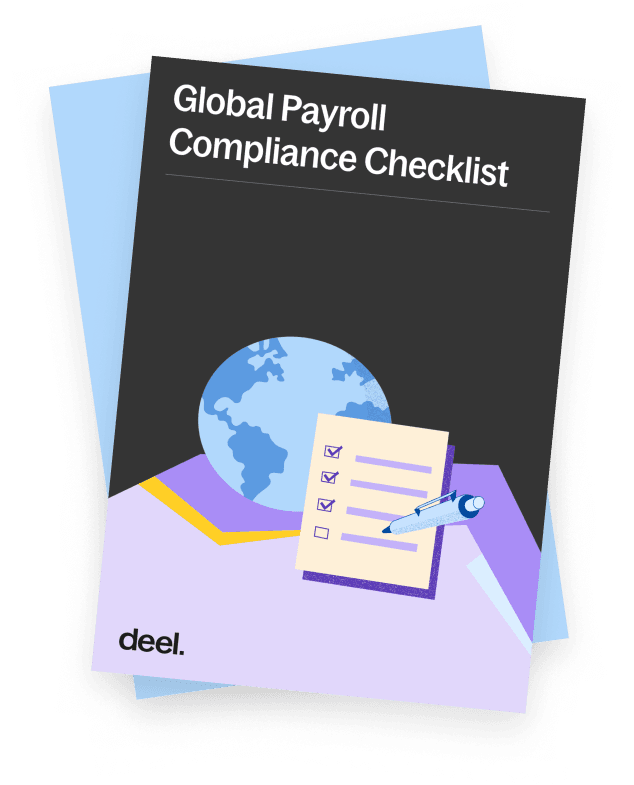Remote Work Glossary
- Results for "undefined"
Table of Contents
Types of payroll reports
What metrics should you include in a payroll report?
How do you create a payroll report?
What are the best practices for creating payroll reports?
Payroll reporting software and tools
How can payroll reports support compliance?
Simplify payroll reporting with Deel
Frequently Asked Questions
What is payroll report
A payroll report is a document that summarizes all payroll-related transactions, employee compensation, and tax liabilities for a specific pay period or timeframe.
Generated from your accounting and payroll records, these reports provide a complete snapshot of how much you’re paying employees, what taxes you’re withholding, and what you owe to government agencies.
Payroll reports serve three critical purposes.
First, they help you verify accuracy by cross-checking data from employee timesheets, tax forms, and pay stubs.
Second, they’re essential for tax compliance, providing the documentation you need for quarterly and annual filings with the IRS and state agencies.
Third, they give you financial visibility into your largest operating expense: employee wages and benefits.
The information in a payroll report typically includes:
-
Hours worked
-
Employees’ pay rates
-
Overtime accrued by employees
-
Taxes withheld from employee wages
-
Vacation benefit allowances
-
Perk management
-
Employer tax contributions
Some reports focus on individual employees, while others aggregate data across departments or the entire organization.
For businesses with distributed teams, payroll reports become even more complex. You’re not just tracking federal payroll taxes but also navigating state unemployment tax requirements, local wage laws, and international compliance standards.
That’s where understanding different types of payroll reports becomes essential.

Types of payroll reports
Different payroll reports serve various purposes. Here are the most common types you’ll encounter, though many businesses customize their payroll reporting to fit specific metrics and operational goals.
Payroll summary report
The payroll summary report is your high-level overview.
Compiled by payroll administrators, this report displays payment information for individual employees, departments, or the entire company within a set date range.
A typical payroll summary report includes gross pay, net pay after deductions, and tax withholdings. In the US, this includes Federal Insurance Contributions Act (FICA), federal income tax, state income tax, and local taxes where applicable. It also tracks employer contributions like the Federal Unemployment Tax Act (FUTA) and state unemployment insurance.
This report is handy for budget planning and forecasting. By analyzing payroll summary reports across multiple pay periods, you can identify trends in payroll expenses and make informed decisions about hiring, raises, and benefit offerings.
Payroll detail report
While the summary provides the big picture, the payroll detail report offers granular, line-by-line information about each employee’s compensation history.
Payroll detail reports are invaluable for troubleshooting discrepancies, conducting internal audits, and responding to employee questions about their paychecks. They’re also critical when preparing for external audits or investigations.
Payroll tax liability report
This report zeroes in on your tax obligations. It shows precisely how much you’ve withheld from employee wages for various payroll taxes, how much you’ve already paid to government agencies, and what you still owe.
The payroll tax liability report pulls information from employee tax forms like Form W-2 (Wage and Tax Statement) and is essential for preparing quarterly filings such as Form 941 (Employer’s Quarterly Federal Tax Return) in the US.
At year-end, you’ll also need this data for Form 940 (annual federal unemployment FUTA tax return) and the transmittal of wage and tax statements to the Social Security Administration.
Getting this report right isn’t optional. Errors in tax reporting can trigger penalties, interest charges, and unwanted attention from tax authorities.
Employee summary report
The employee summary report focuses on individual worker information: name, date of hire, job title, hourly rate or salary, tax withholding elections, benefit enrollments, and year-to-date earnings.
This type of payroll report is useful for HR purposes, performance reviews, and when employees need documentation for loan applications or other personal financial matters. It’s also what employees reference when filing their state income and federal income taxes at year-end.

Retirement contributions report
If you offer 401(k), 403(b), or other retirement plans, you need a dedicated report tracking both employer and employee contributions. This report breaks down how much each employee earns and contributes, what your company matches, and the total year-to-date retirement savings.
Retirement contributions reports are essential for plan audits, compliance testing, and providing documentation to your retirement plan administrator.
Paid time off (PTO) report
The PTO report tracks employee time off balances, accruals, and usage. It shows vacation days, sick leave, personal days, and any other paid time off categories your company offers.
This report helps you monitor PTO liabilities, the amount you’d owe if everyone cashed out their unused time, plan for staffing during high-usage periods, and ensure employees are taking adequate time off for work-life balance.
Workers’ compensation report
This specialized report provides the data insurance carriers need to calculate workers’ compensation premiums. It typically breaks down payroll by job classification, since different roles carry different risk levels and insurance costs.
Payroll service charges report
If you use a payroll provider or outsourced payroll processing service, this report shows what you’re spending on those services. It helps you evaluate whether you’re getting good value and can inform decisions about switching providers or bringing payroll in-house.
What metrics should you include in a payroll report?
Understanding what to track in your payroll reports is just as important as knowing how to create them.
Here are the essential metrics that should appear in your payroll data:
-
Compensation metrics form the foundation. This includes gross wages or income, net pay, overtime hours and pay, bonuses and commissions, and reimbursements.
-
Tax-related data is non-negotiable for compliance. Track federal income tax withheld, state and local tax withholdings, FICA taxes, FUTA tax, and state unemployment tax (SUTA). Each of these has specific reporting requirements and deadlines.
-
Itemized benefit deductions. This includes health insurance premiums, retirement plan contributions, HSA or FSA contributions, life insurance, and any voluntary benefits like gym memberships or commuter benefits.
-
Employer costs give you the full picture of what each employee actually costs your business. Beyond gross wages, this includes employer-paid taxes, employer retirement contributions, employer-paid benefit premiums, and workers’ compensation insurance.
-
Time and attendance data helps you verify payroll accuracy. Track regular hours worked, overtime hours, PTO used, unpaid leave, and any other time categories relevant to your business.
-
For businesses managing global teams, you’ll also need to track country-specific requirements, currency conversions, local benefit mandates, and compliance documentation for each jurisdiction where you have employees or contractors.
Deel Payroll
How do you create a payroll report?
Creating payroll reports can be done manually or through automated payroll software. The approach you choose depends on your team size, complexity, and available resources.
Step 1: Determine reporting frequency and purpose
Start by deciding what you need to report and how often. Most businesses generate payroll reports for each pay period (weekly, biweekly, or monthly), quarterly for tax filings, and annually for year-end compliance and planning.
The purpose drives the content: a report for budgeting looks different from one prepared for a tax audit.
Step 2: Gather source data
Collect all relevant information from your payroll processing system.
This includes employee timesheets or time-tracking data, current pay rates and salary information, tax withholding forms (such as the W-4 for federal and state equivalents), benefit enrollment elections, previous payroll records for year-to-date calculations, and any adjustments or corrections from prior periods.
Step 3: Calculate totals and withholdings
For each employee, calculate the gross pay based on the hours worked and applicable pay rates.
Then determine all applicable deductions: federal income tax based on W-4 elections, state and local taxes, FICA taxes (6.2% for Social Security up to the wage base, 1.45% for Medicare), benefit deductions, and any garnishments or other mandatory withholdings. Finally, calculate net pay.
Step 4: Generate the report
Most modern payroll software automatically generates reports with just a few clicks, pulling data directly from your employee database and payroll records. The software handles the calculations, applies current tax rates, and formats everything into readable reports.
If you’re creating payroll reports manually using spreadsheets, use payroll journal entry templates to ensure consistency and reduce errors. However, manual payroll processing significantly increases the risk of mistakes, especially as your team grows or you expand into new locations.
Step 5: Review for accuracy
Before finalizing any payroll report, double-check key figures.
Verify that total hours match timesheet records, confirm tax calculations are using current rates, ensure year-to-date totals are accurate, and check that all employees who should be included are present in the report.
Cross-reference with previous reports to catch any unusual variances.
Step 6: Store and distribute
Save completed reports in a secure location with appropriate access controls.
Distribute relevant portions to stakeholders: summary reports to finance teams, tax reports to your accountant, individual employee reports to workers, and compliance reports to government agencies as required.
Set a recurring schedule for creating payroll reports so they become routine rather than last-minute scrambles. Dedicate specific time each pay period, quarter, or year to focus on payroll reporting and analysis.
Leading Global Hiring Platform
What are the best practices for creating payroll reports?
Following best practices for payroll reporting saves time, reduces errors, and ensures compliance with evolving regulations.
Automate wherever possible
Manual payroll processing is time-consuming and error-prone. Payroll software not only speeds up report generation but also automatically updates tax rates, flags potential errors, and maintains audit trails.
For companies with global teams, automation becomes essential for managing multiple currencies, tax jurisdictions, and compliance requirements across different regions.
Maintain consistent schedules
Create a payroll reporting calendar that aligns with your pay periods, tax filing deadlines, and internal planning cycles. Consistency helps you spot trends, catch errors early, and avoid missed deadlines that trigger penalties.
Keep detailed documentation
Store all supporting documents related to each payroll report: timesheets, benefit enrollment forms, tax withholding elections, and correspondence about adjustments or corrections. You’ll need this documentation if questions arise or if you are audited.
Reconcile regularly
Don’t wait until year-end to reconcile your payroll data with accounting records, bank statements, and tax payments. Monthly reconciliation helps you catch discrepancies while they’re still fresh and easier to fix.
Review for anomalies
Look for red flags, such as sudden changes in payroll expenses, duplicate payments, misclassified workers, or incorrect tax withholdings. Many payroll errors compound over time, so catching them early prevents bigger problems.
Limit access and maintain security
Payroll reports contain sensitive personal and financial information. Implement role-based access controls, use secure storage systems, and audit who accesses payroll data. Train anyone who handles payroll on data privacy best practices.
Stay updated on compliance changes
Payroll tax rates, wage laws, and reporting requirements are subject to frequent changes. In the US, subscribe to updates from the IRS, state tax agencies, and the Department of Labor. Better yet, use payroll software that automatically incorporates regulatory changes.
For businesses managing international payroll, partnering with a global payroll provider like Deel ensures you meet local compliance requirements in each country where you operate, from tax reporting deadlines to mandatory benefit contributions.

Payroll reporting software and tools
The right payroll software transforms payroll reporting from a tedious manual process into an automated, accurate, strategic function.
Modern payroll platforms provide automated report generation across all common report types, real-time dashboards that display key payroll metrics, customizable reports tailored to your specific needs, and built-in compliance tools that automatically apply current tax rates and regulations.
They also provide secure cloud storage with appropriate access controls and integration with accounting, HR, and time-tracking systems.
When evaluating payroll software, consider your specific needs.
Small businesses with all employees in one state have different requirements than enterprises with global distributed teams.
Key factors include:
-
Whether the system handles multi-state or international payroll
-
The level of automation and how much manual data entry is required
-
Reporting flexibility and customization options
-
Compliance support and how updates are handled
-
Integration capabilities with your existing tech stack
-
Quality of customer support and implementation assistance
For companies hiring internationally, a specialized global payroll solution like Deel provide end-to-end payroll processing and reporting across 130+ countries. Deel automatically handles local compliance requirements, currency conversions, and country-specific reporting formats.
Deel also consolidates data from multiple countries into unified reports, giving you a single source of truth for global payroll expenses and metrics.
The investment in quality payroll software typically pays for itself through time savings, error reduction, and avoided penalties. More importantly, it frees your team to focus on strategic payroll analysis rather than manual data compilation.
How can payroll reports support compliance?
Payroll reports are essential for meeting legal and regulatory requirements.
Tax filing requirements
Every payroll report feeds into mandatory tax filings, whether that’s Form 941, Form 940, Form W-2, W-3, or others.
The IRS cross-references these submissions, and discrepancies trigger audits or penalties.
Certified payroll reporting
Certified payroll reporting is a specialized requirement for government-funded projects.
Contractors on federal construction or public works projects must submit certified payroll reports to prove compliance with prevailing wage laws, such as the Davis-Bacon Act. These reports document each worker’s classification, rates, hours, and wages paid.
You’re certifying under penalty of perjury that the information is accurate. Inaccuracies result in back pay requirements and potential debarment.
Audit defense and record retention
During IRS or Department of Labor audits, payroll reports are your primary defense.
Comprehensive reports prove you tracked hours accurately, calculated taxes correctly, and paid employees properly. Without documentation, auditors make worst-case assessments, which can result in compounded penalties.
The IRS requires retaining payroll records for at least four years, though many states mandate longer periods.
Keep all supporting documentation: timesheets, tax forms, and benefit elections. For businesses with employees across multiple states or countries, payroll reports must track jurisdiction-specific requirements, tax rates, and filing deadlines to maintain compliance everywhere you operate.

Simplify payroll reporting with Deel
Payroll reports are your financial command center for one of your largest business expenses. Done right, they provide the accuracy, compliance, and insights you need to manage payroll confidently and strategically.
Start by implementing consistent reporting schedules aligned with your pay periods and tax deadlines. Invest in payroll software that automates calculations, integrates with your other systems, and keeps pace with regulatory changes. Focus on the metrics that matter most for your business, whether that’s departmental cost analysis, benefit utilization, or international payroll consolidation.
Most importantly, treat payroll reporting as an ongoing process, not a quarterly scramble. Regular attention to payroll data helps you catch errors early, stay compliant, and make informed decisions about your workforce.
Ready to simplify your payroll reporting? Deel Payroll handles payroll processing and reporting for teams worldwide, ensuring accuracy and compliance regardless of your employees’ locations. Book a demo to see how we can streamline your payroll operations.
Frequently Asked Questions
What is the difference between a payroll report and a payroll register?
A payroll register is a specific type of payroll report that lists all employees paid during a particular pay period, showing gross pay, deductions, and net pay for each. It’s essentially a detailed record of a single payroll run.
Payroll report is a broader term that includes registers, tax liability reports, summary reports, and other payroll-related documentation.
How long should I keep payroll reports?
The IRS requires businesses to keep payroll records for at least four years. However, many states have longer retention requirements. Best practice is to keep detailed payroll reports for at least seven years, which covers most federal and state audit periods and statutes of limitations.
Can payroll reports help identify cost-saving opportunities?
Absolutely. Analyzing payroll reports across time periods can reveal patterns in overtime spending, benefit utilization, turnover costs, and departmental efficiency.
These insights help you make data-driven decisions about staffing levels, compensation structures, and benefit offerings.
What’s the most common payroll reporting mistake?
Misclassifying workers is the most costly mistake. Treating employees as independent contractors or vice versa affects tax withholdings, benefit eligibility, and reporting requirements.
The penalties for misclassification can include back taxes, fines, and legal liability for both federal and state violations.
Do I need different payroll reports for remote workers in different states?
Yes. When employees work remotely from different states, you typically need to withhold and report taxes for each state where they’re working.
This means generating state-specific payroll tax reports and filing in multiple jurisdictions. Some states have reciprocity agreements that simplify this, but many don’t.

